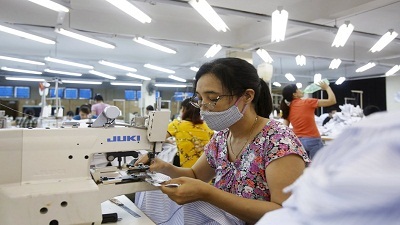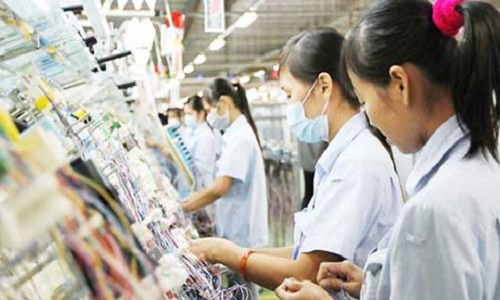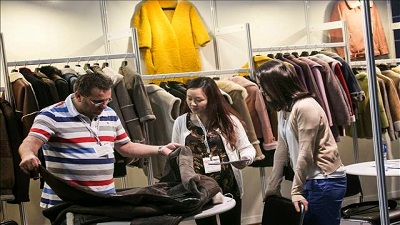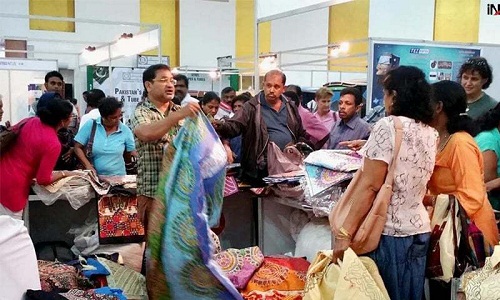FW
Exporters of textile and leather products in Pakistan want a zero-rating regime available to them. They say this will help them compete with their rivals in international markets. Pakistan’s exports of textile and leather products have been persistently declining. And the exporters’ margin of profit is a meager 4 to 5 per cent. Local taxes and levies are reducing the liquidity of export oriented sectors. Increasing prices of raw materials, high banking service charges, high export refinance rates and the uneven taxation system are added reasons for falling exports.
Exporters want electricity and gas tariffs to be reduced and that the export sector should have a separate head of account in the tariff structure. They also want export-oriented industries to be ensured with a regular supply of all utilities to run the manufacturing units without any interruption.
Another complaint of theirs is that trade organisations are not consulted during the preparation of policies and neither are their recommendations included in decision making. Sales tax refund claims are pending approval. They say any delay in implementing the zero-rating regime would not only make it difficult for exporters to meet targets it would also make things worse for the already deteriorating sector.
"As Robert Sinclair, COO of LF Sourcing observed at the recent Prime Source Forum (PSF) conference in Hong Kong, Vietnam with or without TPP, remains a good sourcing destination, but warns it has its limitations. Sinclair compares the country's population of just over 90 million to that of China's Guangdong province, which has a labour pool of 104 million."

While all member countries stand to benefit from Trans-Pacific Partnership (TPP), Vietnam is poised to be TPP’s biggest winner. According to a study, compared to a baseline with no TPP -- Vietnam’s income gains in 2025 with a comprehensive TPP would be over 13 per cent higher, while its exports in 2025 would be over 37 per cent greater. Much of these gains would come, especially initially, from Vietnam’s growing production and export of apparel and footwear, resulting from the phase out of high duties in TPP partner countries, especially the United States and Japan.

While acknowledging this potential, a number of industry executives are expressing a degree of skepticism about whether Vietnam will be sufficiently prepared to fully appreciate any benefits from countries investing in its economy - and more specifically, its textile and clothing industry.
As Robert Sinclair, COO of LF Sourcing observed at the recent Prime Source Forum (PSF) conference in Hong Kong, Vietnam with or without TPP, remains a good sourcing destination, but warns it has its limitations. Sinclair compares the country's population of just over 90 million to that of China's Guangdong province, which has a labour pool of 104 million. “If we have to factor that in, there is a limitation on what they're going to be able to produce and therefore benefit from TPP as a manufacturing country.” He believes this uncertainty means the door is left open for the Asian subcontinent in general and India in particular.
Challenges ahead
Li & Fung grew its business in Vietnam by 50 per cent, making it the company's second-largest sourcing destination after China between 2014 and 2015. The company employs 325 staff in the country and is obviously a big proponent of it. But even so, Sinclair reiterates concerns over its threshold and limitations.
Raphael Madarang, Director of global trade compliance and supply chain solutions for APL Logistics believes Vietnam faces a number of challenges if it is to take on the volume of business expected as a result of the fall-out from China, particularly from an infrastructure perspective. He mentioned this in the back drop of the news that Vietnam could experience a manpower shortage by 2017 and 2018, so they may not have enough people to run the factories and the mills.
One of the unique features of the TPP for textiles is that it has a yarn-forward rule of origin, which means the yarns used in the products should only be sourced from member countries. Vietnam, however, sources a large amount of yarn from China, a non-TPP country. Ultimately, this means Vietnam will have to make up for that production with a substantial investment in domestic spinning and dyeing facilities. Madarang felt, from a logistics standpoint, there is going to be a lot of movement in raw materials. He also expects a possible movement of raw materials from the US to Vietnam in order for them to capture this benefit since there is also a lot of yarn production in the US.
Foreign investment options
A potential solution to this situation is seen by cotton yarn, fabric and garment supplier Texhong Textile Group is foreign investment. The China-based company began investing in Vietnam in 2006, and last year invested in 500,000 new spindles, bringing its total in the country to 7 million. In 2015, around half of Texhong's capacity came from Vietnam, making it one of the first enterprises in China to have more capacity abroad than at home.
Explains Hong Tianzhu, CEO of Texhong that for Vietnam to enjoy TPP benefits and avoid a shortage of fabrics, there is a need for more weaving plants. In a bid to meet that potential demand, the company is building a 3,300 sq. ft. integrated industrial park in Quang Ninh Province to support the future development of Vietnam's textile industry. The so called Vietnam Galaxy project will include weaving, dyeing and apparel production facilities, and is due to begin production in 2017.
Texhong's investment will not only serve Vietnam's needs, but also help alleviate some of the pressure from higher costs in China. Nonetheless, Tianzhu also has confidence in the consumer market in China, and so, in a further strategic move, is positioning the industrial park on Vietnam's Northeastern border to serve both markets. Despite Texhong's promise to offer Vietnam a sizeable supply of fabric and yarn, one Malaysian manufacturer believes it is in high end apparel that the country is still lacking. Prabakaran Kesavan, Founder of Venlaakwear International is of the opinion that the service level in China is well-established, as is its R&D. These things take time to be copied into other markets like Vietnam. So there is a time gap. But China is not going to be replaced by the TPP. Gradually maybe, and it will start with the downstream. But we are not in competition with China.
Lenzing’s consolidated revenue climbed six per cent in the 2015 fiscal. This increase is particularly due to higher fiber selling prices, the growing share of specialty fibers in its product mix and positive exchange rate effects. Ebitda (earnings before interest, tax, depreciation and amortization) improved by 20.7 per cent.
Adjusted equity increased by 15 per cent. The adjusted equity ratio amounted to 50.6 per cent, the highest level since 2006. Net financial debt was sharply reduced by 27 per cent. Accordingly the ratio of net financial debt to Ebitda declined from 1.9 at the end of 2014 to 1.1 at the end of 2015. The return on capital generated by the Lenzing group improved thanks to the positive earnings development. As a result, the return on capital employed increased to eight per cent compared to minus 0.1 per cent in the previous year. Return on equity rose to 13 per cent.
The share of specialty fibers as a percentage of total group revenue was 40.5 per cent in the 2015 financial year compared to the 35 per cent the previous year. Expenditures for research and development were increased by 47 per cent in line with the company’s strategy of focusing on the development, production and marketing of innovative specialty fibers.
www.lenzing.com/
As a ‘guest nation,’ India has been invited as the first ever country to be hosted at the Sydney Royal Easter Show (SRES). This is seen as a great opportunity for India to showcase its indigenous skill and prowess overseas. India’s participation is being viewed as a gesture towards elevating mutual cooperation.
Known as the Easter Show, the Sydney Royal Easter Show is a celebration of Australian culture and the flagship event of the Royal Agricultural Society of New South Wales (RAS), a not-for-profit organisation founded in 1822 to measure and maintain excellence in agriculture. Not only does it celebrate the contribution of agriculture in Australia, but it also applauds its highest achievers in agricultural excellence.
At the opening of the Indian pavilion, the visiting delegation from India was led by officials of the India Trade Promotion Organisation (ITPO), a government of India enterprise, promoting Indian trade globally.
Praising the contribution of Indian migrants to Australia, RAS Chief Executive Michael Kenny said, today there is a community of nearly 400,000 Indian Australians who contribute to the greater national community in their roles as farmers and rural workers as well as teachers, doctors, accountants, engineers and researchers. Over 85 exhibitors from India will be housed in the Guest Nation India Pavilion, for 14 days during the Easter Show.
The latest initiative of the Irish value retailer Primark, a member of a long list of alliances aimed at improving the well-being of garment workers and developing sustainable practices is the German Partnership for Sustainable Textiles (Bündnis für nachhaltige Textilien), which works towards achieving social, environmental and economic improvements throughout the textile supply chain.
Established in 2014, the multi-stakeholder initiative has international fashion retailers such as H&M and Adidas among its members, as well as trade unions. According to Paul Lister, who is responsible for Primark’s Ethical Trade Team and CSR at Associated British Foods, Primark has been working hard for the last decade to ensure that the rights of workers within our global supply chain are respected and the lives of people working within the garment industry in emerging markets markedly improve, as industrialisation brings new jobs and opportunities.
As part of this work the company have collaborated with many organisations, including the Deutsche Gesellschaft für Internationale Zusammenarbeit GmbH (GIZ), with whom they have worked for more than five years in Bangladesh. For Primark, it is a logical next step to join the Textilbündnis and they look forward to actively participating in the working groups.
Bangladesh’s readymade garment factories are getting environment-friendly. The aim is to create a brand image, improve productivity, reduce health and safety hazards at the workplace and the cost of doing business. The objective of the readymade garment sector is to achieve internationally recognised standards of working conditions in garment factories.
Since Canada is one of the global leaders in green industries, Bangladesh may use the Canadian experience to transform its enterprises. CSR activities make a company innovative and competitive. Slips and trips, falls from heights, back pain, muscular skeletal disorders, occupational asthma, hearing loss, fire, stress and fatigue are the main symptoms of ill-health and accidents at work.
Eco-friendly units help reduce the cost of doing business as they use energy-efficient machinery, consume less electricity and water and increase productivity. Buyers also prefer an environment-friendly factory while placing orders as, among others, it offers comfortable working conditions for workers.
Since the industry in Bangladesh has a vision of touching $50 billion in exports by 2021, a green approach can help the industry achieve the target. Bangladesh has made significant progress in the readymade garment sector over the past two years and major reforms have been undertaken to improve safety, security and labor rights.
Pakistan’s textile exports declined by 8.76 per cent during the first eight months of the current fiscal year. Raw cotton exports declined by 46.58 per cent, cotton yarn exports by 32.80 per cent and cotton cloth exports by 10.69 per cent. Cotton carded or combed exports fell by 98.12 per cent, yarn other than cotton yarn export dwindled by 21.20 per cent.
Similarly there was a fall in exports of knitwear, bed wear, canvas and tarpaulin, art, silk and synthetic textiles, and made-up articles in the same period. However, exports of towels, readymade garments and other textile materials increased when compared to the same period of last fiscal year.
Textile exports in February 2016 compared to February 2015 declined by 5.30 per cent. Cotton yarn exports declined to 106 million dollars in February 2016 from $171 million in February 2015, cotton cloth fell to $183 million from $220 million, towels to $60 million from $66 million and raw cotton from $717 million from $672 million.
Made-up article (excluding towels and bed wear) exports fell to $48 million in February 2016 as compared to $57 million for the same month of last fiscal year.
Consumers in developed world have high expectations from the apparel brands they buy. They expect the clothes to not have been made in inhuman and unsustainable conditions like sweat shops, or use child labor, labour is not being squeezed to do more number of hours or being under paid. Often, manufacturers in underdeveloped countries in order to get more business don’t take proper care of human resource or apply appropriate safety measures. Meanwhile, brands are facing pressures from various consumer groups to take compliance code of conduct seriously, check all details of their supplier units and factories, highlighting the need for transparency in their supply chain.
In the just concluded PSF 2016, a panel discussion on brands and in turn manufacturers was the spotlight. It talked about the need for transparency in supply chain and risks arising from there in. The panel deliberated that better communications and collaborations can help mitigate mutual risks and provide competitive advantage for both the parties, brands and suppliers. The panel also explored how companies are evolving their communication activities to handle this ‘new normal’ and what opportunities this represents.
Obviously transparency in supply chain could expose brands to a lot of risks, if their suppliers are not compliant. Rolling out the discussion, Laura Tyson, SVP, Fleishman Hillard, said she has been working in Hong Kong in communication and media, with a focus on supply chains, “Brands with supply chain focus keep coming back asking us, could we help them communicate, keeping their brand reputation intact, as this is becoming a basic need for brands to know how their supply chain is working?”
Alessandra Cocchi, MD, East Max Fashion, sharing her experience with high fashion brands, “We are increasingly facing the situation where consumer expectations are going up, they would expect to know the origin of our products. We face a lot of pressure to raise our level of manufacturing in terms of compliance, to know if we are fighting potential problems related to environment, maintaining and improving efficiency, without increasing prices etc.” Hence, more transparency is required at supply chain levels.
Alex Thomas, VP, Manufacturing Excellence and Technical Services, VF Asia pointed out that if we are not aware and proactive as an industry then government and regulators will enforce or NGOs will enforce as safety is aconcern for every country and everyone.
While agreeing to the risk exposure the panel agreed compliant working and communication with consumer could actually open up opportunities, “Opportunities can be seen, as we have been enforced to engage positively with our suppliers. What we have done is, we have started communicating with brands on the format of fair business practices. In the process, information is shared regarding fair profits, though we have to offer our factories a long term partnership,” explained Alessandra. However, this is a gradual process and may take a few years, “But suppliers are happy to work, as they find it suitable, and they can see that the brand is sustainable and offers a long term business.”
Whe said being politically correct, they identify the kind of suppliers, who they can work with and share standard practices and would try to help suppliers getting oriented. “But if one of our supplier doesn’t pass the test in EU, we have to reject that supplier. Today, if certain suppliers don’t pass the test in EU or in the US, irrespective of the supplier understanding, we have to discontinue.”
“According to me, the risk in communication, is first to do with big data that we have,” says Alex Thomas, VP, Manufacturing Excellence and Technical Services, VF Asia, “As we have a lot of information, we assess the data, about factories in our supply chain. Secondly, we at VF Corp have 32 brands, all these brands have different DNAs. We have to act keeping brand promises, on other end of spectrum, we have brand promise with a top retailers like Walmart, where we need to work mainly on productivity and saving cost for the value promise, this we may be doing in factories in Mexico, where there are wages 1.5 times higher than that of any other Asian manufacturing countries. Third aspect is engagement, we put all this information on public forum, not only corporate, but bottom up, right upto consumer level, so we go for a lot of engagement, not only with supply chain partners but with the end consumer.” He said as a brand and manufacturer they understand pressures from media, NGOs so they started with a lot of engagement, and in the last five years, a lot of consolidation has taken place, “we don’t source from unknown suppliers anymore. We work with strategic partners, and with them comes more engagement, everyone is able to see direct impact.”
Coming to consumer engagement, Laura asked the panel what kind of opportunities this brings on the table. Alex pointed out not only at consumer levels but at community levels, brand promise needs to be maintained. Alessandra explained, “We have a scoring system based on the working with the suppliers, brands at high end or others may have a different social system. Synchronization of social system is calibrated for different kind of brands. We may have worked extensively with high end brands, we face challenge to explain to the consumer what that scoring system is all about.” While benefits of consumer engagement that facilitates a better understanding of trends and consumer behaviour, I think there’s huge differentiation in the way consumer looks at origin and quality, for some regular cotton is fine, and for a few three times cost of organic cotton is also fine,”
Andreas Kim, MD, Greater China, Lectra, China, shared a different perspective, “Historically, we in apparel and fashion industry face the need for transparency or communication internally or externally. Growing fast fashion generally needs more suppliers than traditional suppliers, 85 per cent of communication is done on excel sheet, 5 per cent of that is still being done by fax and only 10 per cent is digital communication.” He felt there is a need to come together and that there’s a need to standardise, what we do and what we communicate. “We may follow Higg’s Index or any other process that is considered seriously, through these standardization, we can compare. We necessarily don’t reduce competition because of standardization but increase opportunities. Standardization enables level playing for everyone,” he felt. Today, every brand has its standard process, so every manufacturer has to go through the same process again and again, this is not a consistent way, as for a manufacturer we need lower cost and standardization means lowering the cost, Kim opined. For a brand it is important to have consistency, in terms of price, quality, specification. “I invite all associations to come together to create standardizations in processes. And now through digitalization, it will enable us to be more efficient to achieve standards. Standardization can sure reduce the risk of communication, however you can never be sure that risk is over, risk will always be there, but standardizations will reduce unforeseen risks,” Kim summed up.

Ethiopia is fast emerging a strong destination for sourcing apparel. The country’s clothing and garment sector is undergoing rapid expansion fuelled by foreign investment as companies seek to reduce their reliance on countries like China and Bangladesh.
Ethiopia grows some of the world’s finest cotton and has a rich textile spinning and weaving history, yet its importance on a global scale remains insignificant as of now. With several government incentives, and priority given towards developing the textile and clothing industry across the value chain, a viable business environment and duty free market access to both US and EU, Ethiopia is now beginning to attract international buyers and investors. Having experienced approximately 8 per cent GDP growth consistently since 2008 and a stable political framework since 1995, it remains largely un-explored and un-tapped.

Apparel firms such as Hennes & Mauritz (H&M), Asos, George at Asda, Calzedonia, Primark, Tesco and PVH are sourcing from Ethiopia, with the latter describing its experience in the country as ‘nothing short of exceptional.’
However, Dr Arkebe Oqubay, Minister and Special Advisor to the Ethiopian Prime Minister is optimistic about the country's Growth and Transformation Plan (GTP), He believes with economic growth Ethiopia will achieve middle income status by 2025. Its vision is for GDP to grow by 11 per cent every year for the next 10 years, and for manufacturing to grow by 25 per cent year on year for the next decade. Oqubay puts forth his views while was addressing delegates at the recent Prime Source Forum held in Hong Kong as the keynote speaker.
Ambitious moves
Ethiopia has been known in last decade as the fastest growing economy and the country’s ambition is evident with the construction of the Hawassa industrial park, set up in partnership with industry majors like PVH Corp, owner of the Calvin Klein and Tommy Hilfiger brands. The $246 million eco-park has been built in a record time of just nine months, on 130 hectares of land in the capital Addis Ababa. It is expected to create around 60,000 jobs and generate a total export value of $1billion.
Also central to the country's strategy is its ambition to build a vertically integrated apparel and textile industry. According to Oqubay, the plan is to use its mass of unused land to plant GM (genetically modified) cotton to become one of the major producers in the world. The minister said, other challenges if the country is to achieve its goals, however, include a focus on productivity and ensuring it has a steady stream of skilled labour to produce garments for major brands it has attracted to the project – including India's Arvind and Raymond, Hong Kong's Epic and TAL Industries, and Indonesia's Pityu.
Road ahead
The industrial park at Hawassa is just one of seven prospective industrial parks the government is developing. The vision is to create two million manufacturing jobs over the next 10 years with the construction of 20 million sq. mt. of factory space per year, building on a steady growth rate of 20 per cent annually over the last five years. This is thanks to foreign direct investment from countries including Turkey, India, China, a number of EU nations, and the US.
Oqubay said, this is the best opportunity for firms wanting to establish manufacturing plants in Africa, where Ethiopia is one of the best destinations. Located close to Europe, the Middle East and Asia, the country enjoys preferential market access to Europe through the Everything But Arms (EBA) deal, and duty-free access to the US through AGOA (the African Growth and Opportunity Act).
Ethiopia's advantages include a population close to 1 billion that is growing by 2.3 million annually, a steady economy, location, low crime, investment in skills training, and substantial investment in infrastructure - 60 per cent of the government's budget to be precise, said Oqubay.
Central to this is the construction of a Chinese-built electric railway network from Addis Ababa to the Red Sea port of Djibouti, with the eight rail corridors that make up the new 6,000 km network. Once completed, it will create a series of key trade routes to neighbouring countries.
However, Ethiopia has a long way to go if it wants to match the apparel exports of countries like Myanmar at $1.5 billion, Turkey at $18.7 billion, and Vietnam at $24 billion. In 2014, Ethiopia's apparel exports reached just $112 million. While the country is known for its cheap labour, it is also known for low labour productivity, high personnel rotation and corruption. But the key point is that top leadership is committed to addressing the issues of transparency. According to Oqubay , “it is the basis for success so we have been keen to build this trust. One of the major shifts in this industry over the next ten years will be the shift of apparel manufacturing to Africa and I believe it will be East Africa,” he concluded.
Istanbul Modest Fashion Week will take place from May 13 to 14, 2016. This is Turkey’s premier event offering an international platform for designers and brands from the region to seamlessly connect with fashion influencers, media, fashion associations and retail executives.
The event will consist of world class stages, fashion shows, fashion booths and workshops. IFDC is partnering the event. The fashion week will open a gateway to modest style and IFDC intends to play a role in making this a global event. Among IFDC’s contributions will be workshops, talk show, chief guests, leading designers, and more.
In Istanbul, women have an unique relationship with fashion – they dress in a conservative but expressive, colorful and modern way. There are many homegrown design houses in Istanbul as well as a fashion magazine that translates modern trends for conservative women. There is a huge market for high-end conservative fashion in Turkey. Bright colors and modern cuts maintain modesty and Islamic values.
Recent trends highlight versatility, allowing the wearer to tailor designer outfits to conservative tastes. Dresses can be worn over pants, and longer coats make curves less pronounced. One Islamic swimsuit is called burkini, a combination of burkha and bikini.
www.istanbulmodest.com/












